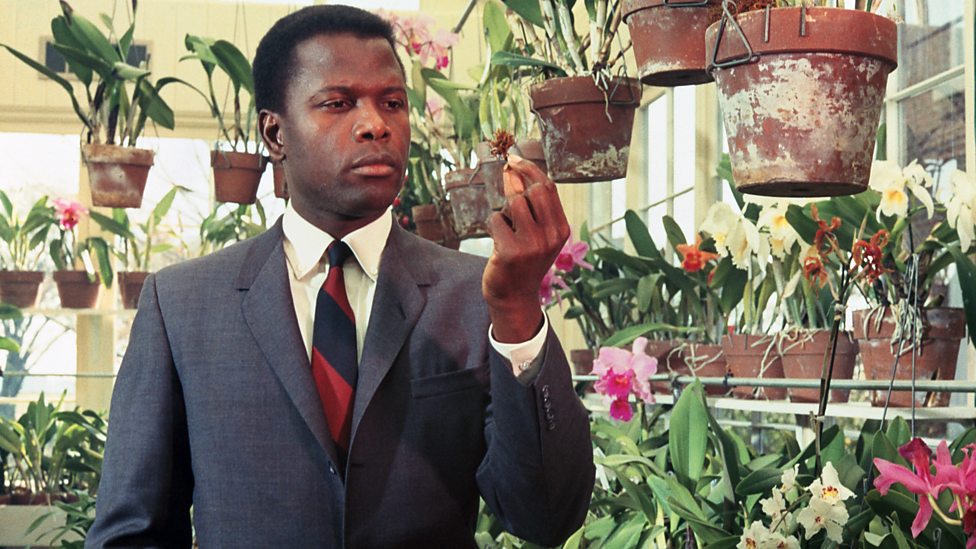When looking at the 2007 AFI List of top 100 movies and asking why did these particular films all make it--what singular quality do they all possess--I come up with...hmm…umm...nothing. Damn it!
Some seem to be on there purely because they’re great films (like 2001: A Space Odyssey). Some are ones that did something for the first time that eventually got repeated a lot (like The French Connection). Some are a representative of a series or genre of movies (like Swing Time). Some are overlong long Charlton Heston movies people feel they have to put on these lists (I’m looking at you Ben Hur).
And then some, like this one, are there because of its social importance.
While the movie would probably be done differently today, it was important to 1967, which was a time full of racial tensions, kinda like now. And also please note that as a white person writing about this, I obviously have a limited perspective on some of these topics. But I’ll do my best to look at what this movie was doing.
This is the fourth post where I’m discussing one of the films from this list (following along with the engaging podcast, Unspooled) noting things you could possibly get from it as a writer, a filmmaker, or just someone who appreciates looking deeper into movies.
Here we are with 1967’s In the Heat of the Night, directed by Norman Jewison and written by Stirling Silliphant.
The eyes are the windows to someone else’s soul
I always discuss the overall theme of each movie (the statement or question that ties everything in the movie together) because as a storyteller, it’s can be incredibly useful to know what makes stories work. This is the secret ingredient--even more valuable than whatever is in Coca-Cola.
In the Heat of the Night is a genre movie, specifically a mystery, but as with all great genre movies, it’s much more than just that.
And this movie deals heavily with the human ability to read other humans and go beyond your initial assumptions or prejudices to see who a person truly is. So the statement this movie seems to be making is “We need to be perceptive to truly see people.”
Mr. Tibbs is fantastic at this. One of his defining qualities is his perception. When Gillespe arrests the wrong person for the Colbert murder on two different occasions, it’s Tibbs who’s able to deduce that each accused person is innocent. He’s the only person to take the time to do that.
It could be argued that being perceptive is the quality of any good detective in a movie. Sherlock Holmes is perceptive. So is Miss Marple. Even Scooby Doo manages to figure out which random bank manager is masquerading as a ghost by the end of each episode.
But Tibbs’ perception extends beyond his job. He sees Gillespie for who he really is, calling out that he’s lonely, which consequently hits a nerve for him (probably since no one has ever seen him that well before). Tibbs also hears what Gillespie really means at the end when he tells him “You take care y’hear.” Tibbs smiles, recognizing how much more Gillespie meant by that and how that’s as close to an affectionate statement that the dude is going to make.
Leslie Colbert being perceptive also is important, since she sees Tibbs for the great detective he is, as well as this police force for the incompetent jerks they are, so she insists that Tibbs takes on her husbands case.
The flip-side
What might be even more important is that In the Heat of the Night shows the terrible consequences of not being perceptive and not seeing the other person.
For every theme, we inherently see the flip-side of it, and in this case we get “Not seeing people has a horrible outcome.” And the outcome in this film is often racism.
Neither Woods nor Gillespie see Tibbs as a person at all when he’s arrested and questioned. He’s apprehended and assumed to be guilty because of his race, and it’s only when he tells Gillespie that he’s a cop does he even look at Tibbs long enough to see that he’s a real person and that he might be innocent (I can only imagine what would happen if Tibbs wasn’t a detective).
He constantly has to deal with these horrible things throughout the movie by people controlled by their prejudices.
The scene where he’s in the cell with the first wrongly accused suspect demonstrates this well. Both of them are in there for things they didn’t do. They’re shrouded in darkness, symbolic of the fact that no one is bothering to see them.
What can be taken away
This movie looks at a lot of difficult subject matter, and it handles most of it tastefully (especially considering the time period).
Since this movie was written in the middle of the American Civil Rights movement, it was inevitably delivering its message to part of the audience that was not-so-progressive. This movie does demonstrate good ways to get your message heard.
Have respect to get respect
It is crucial that the audience, especially the audience who could stand to have their minds opened by the movie, respect Mr. Tibbs. This was a major goal of the filmmakers, as anything else would have been counterproductive.
The main way to achieve this, to have the audience respect a character, is to have that character respect himself.
Tibbs is a man who does. When he’s asked “what do they call you up there?” he doesn’t back down, nor does he shoot an insult back. He strongly says “They call me Mr. Tibbs,” which also indicates how he is respected back in Philadelphia.
When Endicott slaps him, Tibbs slaps him right back, showing that he’s not taking any shit from anyone--especially the fertilizer guy.
A great costume choice is that Tibbs is always better dressed than everyone he’s around. And when we see this in a movie (or real life) we always know that is person with self-respect.
Riding a Trojan Horse
When including such a strong social statement, it’s going to be difficult if the writer is coming on too preachy. The audience that needs to be preached to isn’t going to listen, and the audience that’s on your side could find it condescending (which would probably be the case in this movie considering that the director and writer of this are white).
It’s much better to wrap your message up in an intriguing story. This way, like a Trojan Horse, the message is delivered without the audience fully realizing it.
If this movie didn’t have the genre attached to it and was just a movie about bigotry, it might have not landed with audiences. But since it does wrap up its message up in a mystery, with multiple suspects, twists and turns, a creepy brother, and corrupt cops, it allows for the audience to lower their guards and be more receptive.
All movies use this Trojan Horse technique to some extent or else plots wouldn’t be a thing, but with big messages like this, you probably need to be even more careful about making sure the film never stops being entertaining.
It’s difficult to say if the movie will be on future versions of the AFI list.
There have been movies since this one, made by filmmakers of color, that accomplish some of this movie’s goals better. And perhaps those movies will take its place. I can foresee a future list with movies like Get Out and Black Panther among others appearing. Movies that are currently making a huge social impact and are also as entertaining as they are profound.
However this movie does have a couple things really going for it that could keep it on: its impact on a time period that needed it and the blow-your-mind, timeless performance by Sidney Poitier.
No matter whether or not the movie remains on any particular list, its importance in film history will never be gone.
Thanks for reading! If you liked this, please join our mailing list: https://www.candivan.com/subscribe/





